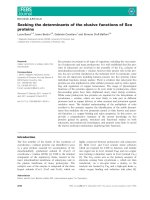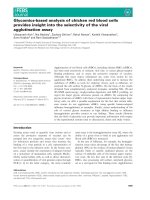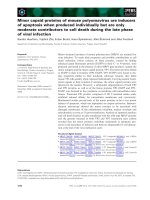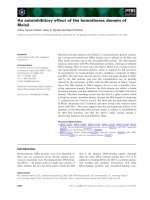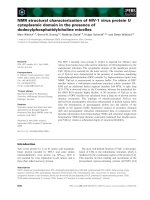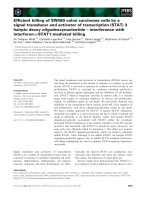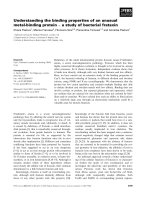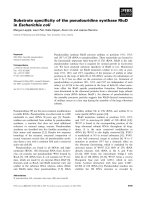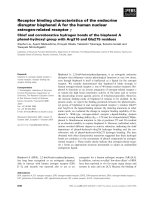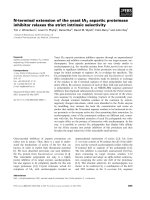báo cáo khoa học: " Assessing the impact of the Australia-United States Free Trade Agreement on Australian and global medicines policy" pps
Bạn đang xem bản rút gọn của tài liệu. Xem và tải ngay bản đầy đủ của tài liệu tại đây (287.84 KB, 10 trang )
BioMed Central
Page 1 of 10
(page number not for citation purposes)
Globalization and Health
Open Access
Debate
Assessing the impact of the Australia-United States Free Trade
Agreement on Australian and global medicines policy
Thomas Faunce*
1,2
, Evan Doran
1,3
, David Henry
1,4
, Peter Drahos
1
,
Andrew Searles
1,3
, Brita Pekarsky
1,5
and Warwick Neville
1
Address:
1
Globalisation and Health Project, Centre for Governance of Knowledge and Development Regulatory Institutions Network Australian
National University, Acton, Canberra ACT, Australia,
2
Medical School and Law Faculty, The Australian National University, Acton, Canberra, ACT
Australia,
3
Newcastle Institute of Public Health, University of Newcastle, Newcastle, New South Wales, Australia,
4
Clinical Pharmacology, School
of Medical Practice and Population Health, University of Newcastle, Newcastle, New South Wales, Australia and
5
Centre for Regulation and Market
Analysis, University of South Australia, Adelaide, South Australia, Australia
Email: Thomas Faunce* - ; Evan Doran - ;
David Henry - ; Peter Drahos - ; Andrew Searles - ;
; Warwick Neville -
* Corresponding author
Abstract
On 1 January 2005, a controversial trade agreement entered into force between Australia and the
United States. Though heralded by the parties as facilitating the removal of barriers to free trade
(in ways not achievable in multilateral fora), it also contained many trade-restricting intellectual
property provisions and others uniquely related to altering pharmaceutical regulation and public
health policy in Australia. The latter appear to have particularly focused on the world-respected
process of federal government reimbursement after expert cost-effectiveness evaluation, popularly
known as the Pharmaceutical Benefits Scheme ('PBS'). It remains uncertain what sort of impacts –
if any – the Australia-United States Free Trade Agreement ('AUSFTA') will have on PBS processes
such as reference pricing and their important role in facilitating equitable and affordable access to
essential medicines.
This is now the field of inquiry for a major three year Australian Research Council ('ARC')-funded
study bringing together a team of senior researchers in regulatory theory from the Australian
National University and pharmacoeconomics from the University of Newcastle. The project
proposes to monitor, assess and analyse the real and potential impacts of the AUSFTA in this area,
providing Australian policy-makers with continuing expertise and options.
To the extent that the AUSFTA medicines provisions may represent an important precedent in a
global strategy by industry on cost-effectiveness evaluation of pharmaceuticals, the study will also
be of great interest to policy makers in other jurisdictions.
Introduction
The final text of the Australia-United States Free Trade
Agreement ('AUSFTA') was signed in Washington on 18
May 2004, by the Australian Trade Minister and the
United States Trade Representative. On 17 November
2004, the parties exchanged notes accepting their respec-
Published: 06 October 2005
Globalization and Health 2005, 1:15 doi:10.1186/1744-8603-1-15
Received: 21 July 2005
Accepted: 06 October 2005
This article is available from: />© 2005 Faunce et al; licensee BioMed Central Ltd.
This is an Open Access article distributed under the terms of the Creative Commons Attribution License ( />),
which permits unrestricted use, distribution, and reproduction in any medium, provided the original work is properly cited.
Globalization and Health 2005, 1:15 />Page 2 of 10
(page number not for citation purposes)
tive implementing processes and the agreement entered
into force on 1 January 2005. The AUSFTA contained
numerous provisions either directly or indirectly related
to medicines regulation in Australia, particularly Annex
2C of Chapter Two, Chapter Seventeen on intellectual
property and Chapter Twenty One on dispute resolution.
It remains uncertain whether the AUSFTA will have either
a detrimental or beneficial impact on access to medicines
and the promotion and maintenance of good health in
Australia. There does, however, appear to have been a sub-
stantial difference in opinion between the Parties over
procedural changes that would result in Australian medi-
cines regulation.
Throughout the negotiations, the Australian Govern-
ment's position was either that the government cost-effec-
tiveness reimbursement system, the Pharmaceutical
Benefits Scheme ('PBS'), would not be included in the
AUSFTA, or that if it was, it was an item of public health
policy whose core components would be protected[1].
After signature, the Australian government maintained
that the fundamental architecture of the PBS remained
unchanged. It acknowledged commitments to make
improvements to the transparency and timeliness of PBS
processes. It also affirmed its reasonable expectations that,
as a result of the AUSFTA, Australian citizens would bene-
fit from faster access to new prescription medicines, that
the price of medicines on the PBS would not increase and
that the text of the AUSFTA made no changes to the cost-
effectiveness methods used to set PBS reimbursement lev-
els[2].
On the other hand, the Deputy US Trade Representative
stated to the US Congress:
The U.S Australia FTA is the first to include non-tariff market
access provisions to address issues in the pharmaceutical sector.
Recognizing the sensitivity of this issue, we drew on studies pre-
pared by the Australian government to propose changes that
would improve transparency and the regulatory procedures for
listing new drugs in Australia. Under the FTA, the United
States and Australia agreed to common principles on facilitat-
ing high quality health care and continued improvements in
public health, including through government support for
research and development in the pharmaceutical industry. We
also agreed to establish a Medicines Working Group to discuss
emerging health policy issues. Australia committed to specific
steps to improve the transparency, accountability and prompt-
ness of the listing process, including establishment of an inde-
pendent review of listing decisions[3].
Representatives of the multinational brand-name phar-
maceutical industry, including its regional organisation
Medicines Australia, claimed that there was no basis to
claims that the US wanted the PBS dismantled[4]. They
argued that the regulatory changes required by these areas
of the AUSFTA would (a) help redress an alleged current
undervaluing of pharmaceutical 'innovation' in Austral-
ian pricing arrangements and (b) stimulate locally-based
research and development, as well as the local, mostly
generic, pharmaceutical industry[5]. They asserted the
negotiated modifications would make Australia's regula-
tory system more oriented to the global market pressures
on industry, more responsible in its approach to intellec-
tual property rights and so more attractive to private
investment, resulting in a net welfare benefit[6].
Others, however, have pointed to US legislation requiring
that nation's negotiators to seek in the AUSFTA provisions
facilitating the "elimination of government measures such
as price controls and reference pricing which deny full
market access for United States [pharmaceutical] prod-
ucts"[7]. The Australian Senate Select Committee on the
AUSFTA concluded:
While no single one of the specific commitments will create
immediate and measurable price rises for the PBS, the new
measures may well over time alter the bargaining power
between the PBS and pharmaceutical companies. This may
have long term ramifications that are not in the interest of Aus-
tralian consumers[8].
Concern has been expressed about AUSFTA provisions
with the potential to encourage higher medicines prices in
Australia. These include provisions in chapter 17 (Intellec-
tual Property) that expand the obligations of the Trade
Related Intellectual Property Rights ('TRIPS') agreement
by prohibiting parallel importation, restricting compul-
sory licensing to "national emergencies of extreme
urgency," prohibiting generic manufacturers exporting to
a patent-expired market when a domestic patent exists
and increasing data exclusivity protections[9].
A significant additional worry for these commentators
was article 17.10.4. For the first time in Australia, this
linked generic regulatory market approval on quality and
safety grounds with the patent status of the relevant brand
name product[10]. This Hatch-Waxman-type provision
was felt to risk brand name manufacturers "evergreening"
soon-to-expire pharmaceutical patents, as had occurred
after comparable regulations were introduced in jurisdic-
tions such as the US and Canada[11]. The academic, com-
munity and parliamentary concern in Australia was so
great on this issue, that it resulted in the Australian gov-
ernment passing "anti-evergreening" amendments to its
AUSFTA implementing legislation. These imposed a $A10
million penalty for a bad faith challenge by a brand name
manufacturer of a generic notification certificate under
the new s26B of the Therapeutic Goods Act 1989 (Cth).
Globalization and Health 2005, 1:15 />Page 3 of 10
(page number not for citation purposes)
They also allowed cost recovery in such circumstances by
the Australian government[12].
Provisions in Annex 2C(1) emphasising the need for
increased government recognition of pharmaceutical
"innovation" and "research and development" were like-
wise viewed by such critics as having the potential to
encourage brand name industry lobbying. This could
potentially weaken, in the long term, the capacity of Aus-
tralia's Pharmaceutical Benefits Advisory Committee
('PBAC') to reject, on clinical and cost effectiveness
grounds, new medicines from inclusion in the govern-
ment's PBS positive reimbursement list, or to reference
their reimbursement price against older products with
equivalent efficacy but much reduced price[13].
In this paper, we present a rationale and outline a draft
plan for a three-year study, funded by the Australian
Research Council ('ARC'), which will examine the impact
of the AUSFTA on a range of regulatory, public health and
industrial interests involved with access to medicines in
Australia. An important initial point to make is that we
consider the AUSFTA is best researched as a component of
an ongoing process of interaction with Australia's medi-
cines policy by the global pharmaceutical industry. This
trade agreement should be viewed, in other words, either
as a catalyst that may enhance the speed of regulatory
change, or a tangible manifestation of industry lobbying
principles that, till now, may have been more implicit. It
would be misleading, in any event, to investigate the AUS-
FTA's potential impacts on Australian medicines policy in
isolation of demonstrable long-term corporate strategies.
Some central issues our study will examine include to
what extent the AUSFTA requires, facilitates, or is likely to
result in, changes to Australia's generic pharmaceutical
industry, as well as its PBS cost-effectiveness system of
pharmaceutical regulation. We also aim to consider rele-
vant net welfare gain or loss; whether the Australian com-
munity will get the same value-for-dollar spent on
medicines, either through Commonwealth government
reimbursement, hospital or patient purchase.
We propose to investigate these questions empirically
(and provide a sound structure for the gradual acquisition
of suitable data). This will be done first by identifying,
with the assistance of qualitative interviews, actual or
likely AUSFTA-associated changes to the structure and
process of Australia's PBAC, as well as the marketing proc-
esses, development and sector competitiveness of generic
pharmaceutical manufacturers in Australia. This aspect of
the study will also review the legitimacy of such actual or
proposed alterations by examining the history of Aus-
tralia's PBS as a social justice measure designed to ensure
universal access to essential medicines. We will also
review such proposed changes for coherence with basic
norms of bioethics, domestic law and international
human rights. We shall then attempt to determine their
actual or potential impact on a range of indicators includ-
ing drug prices expenditure and affordability, drug availa-
bility and equity of access.
We hope that publishing an outline of our proposed study
will further encourage policy discussion, facilitate collab-
orations and provide a template for governments of other
countries planning to enter such agreements. Although
much of the detail of the AUSFTA is specific to Australia,
there are important elements likely to be relevant to future
trade agreements involving the US or other countries that
have a major vested interest in the production, export and
rent generation associated with patented medicines. These
include whether the strengthening of pharmaceutical
intellectual property protection and weakening of medi-
cines clinical and cost-effectiveness evaluation and/or ref-
erence pricing, necessarily involves a weakening of a
nation's social and economic fabric, or the capacity of its
population to age well and age productively.
Background: Australia's PBS in the Context of
the AUSFTA
Australia's pharmaceutical sector is dominated by the
operation of the federally funded PBS, which, after a proc-
ess of clinical and cost-effectiveness evaluation contribut-
ing recommendations to price negotiation, provides
reimbursement (currently approximately 75%) for
around 80% of the prescription medicines used in Aus-
tralia[15]. The PBS does not restrict market access, but
facilitates maximisation of sales volume for listed prod-
ucts. In developing relevant price indices, our study will
also take into account AUSFTA impacts on prices for hos-
pital-used medicines (which can be calculated from the
PBS reimbursement price less the minimum safety net
value) and predict expenditure on medicines costed under
the co-payment level.
Central to our analysis of the impact of the AUSFTA on
medicines in Australia, however, will be an evaluation of
its effect on the PBS. Australia's PBS was established as a
free formulary of essential drugs after the Second World
War by the Curtin-Chifley federal administrations[16]. It
was a social justice measure designed to ensure that all
Australian citizens gained access to affordable, essential
medicines. Legislation to create the PBS had to survive two
High Court challenges and required a successful Constitu-
tional referendum[17]. Successive Commonwealth gov-
ernments used and built upon the 1940s enactments,
before a conservative party enacted the National Health Act
1953 (Cth) ('National Health Act')[18]. This is an
extremely important point, that will be focused on by
ARC research scholar Warwick Neville. The PBS is one of
Globalization and Health 2005, 1:15 />Page 4 of 10
(page number not for citation purposes)
the few examples of public health policy in Australia's his-
tory that appears to have an unequivocal democratic man-
date. Such an historical-jurisprudential perspective on the
social justice aspects of the PBS will be a unique and dis-
tinctive feature of our analysis.
The modern PBS revolves around Part VII section 85 of the
National Health Act 1953 (Cth). Section 101(4) of this Act
states that the relevant Minister, upon the advice of the
PBAC (with secretariat support from the Pharmaceutical
Benefits Branch of the Department of Health and Ageing
('DOHA'), may declare a pharmaceutical listed on the PBS
and so subject to a level of government reimbursement
(except for a patient co-payment) that has been negoti-
ated by the Pharmaceutical Benefits Pricing Authority
('PBPA'). Prior to the AUSFTA, PBS listing was required to
only occur after the Therapeutic Goods Administration
('TGA') and the Australian Drug Evaluation Committee
('ADEC') had approved the relevant pharmaceutical's
safety and efficacy[19]. The AUSFTA, through implement-
ing amendments to the Therapeutic Goods Act 1989 (Cth),
has already produced, as mentioned, a requirement that a
market-entering generic manufacturer provide evidence
that no counteracting patent is claimed, or that the brand
name owner has been notified.
Central to the PBAC's clinical and cost-effectiveness eval-
uation is section 101(3) of the National Health Act. This
requires the PBAC to base its recommendation on: 'the
effectiveness and cost of therapy involving the use of the
drug, preparation or class, including by comparing the
effectiveness and cost [emphasis added] of that therapy
with that of alternative therapies, whether or not involv-
ing the use of other drugs or preparations.' The section
goes on to state that if the product is 'substantially more
costly' than the selected comparator in its class it shall not
be recommended by the PBAC for PBS listing 'unless [it]
provides a significant improvement in efficacy or reduc-
tion of toxicity over the alternative therapy or therapies.'
The PBS system that has evolved under this section is a
variant of pharmaceutical reference pricing[20]. The phar-
maceutical manufacturer's ('sponsor's') submission to the
PBAC nominates a disease indication (and relevant sub-
sets involving patient characteristics) as well as a listing
price supposedly based on the pharmaceutical company's
assessment of the best relevant available data on clinical
effect against a comparator. The comparator is generally
the drug most prescribed on the PBS for the same indica-
tion, but may be the standard medical (non-drug) treat-
ment. Pharmaceutical companies tend to prefer
comparisons against the most expensive drug with the
best 'head-to-head' data, rather than the compound that is
most pharmacologically similar[21]. Part of our initial
task will be to determine what aspects, if any, of this
important public health-related process could be sub-
jected to pressure emerging from the AUSFTA. It will be an
interesting threshold question to ascertain to what extent
members of the PBAC were aware of, or consulted in, the
development of the AUSFTA articles relevant to the PBS.
The PBAC's expert reviewers evaluate whether any of the
assumptions in the submission are unjustifiable and cre-
ate simulations to assess the incremental cost-effective
ratio (the additional cost for an additional beneficial
effect, or Quality of Life Years ('QALY') gained)[22]. The
reports of these experts ('pink pages') are then passed back
to be reviewed by the PBAC, along with an industry
response to them ('blue pages') and the summary from
the Economic Sub-Committee ('ESC') in the 'green pages.'
The process is designed to take six weeks and follows
guidelines set out on the PBS website. The extent to which
such guidelines alter as a result of the AUSFTA and what
impact this has on the PBAC process will be another
aspect of our study.
The PBAC may ask the pharmaceutical manufacturer for
additional information, but has no legal power to compel
its production, even if not covered by 'commercial-in-con-
fidence' protections. The pharmaceutical manufacturer
may be claiming a price premium because of a claimed
additional benefit (that is improved effectiveness, better
adverse event profile or delivery system) conferred by the
new product over its therapeutic rivals. One hypothesis
we hope to test is that brand-name pharmaceutical man-
ufacturers may use Annex 2C(1) of the AUSFTA to seek
price premiums for alleged "innovation" as a separate
issue from cost-effectiveness. If the relevant evidence sub-
mitted does not clearly establish clinical and cost effec-
tiveness, then a process of cost minimization is
undertaken[23]. The extent to which members of the
PBAC are aware of any broader, strategic agenda of the
brand name pharmaceutical industry in making individ-
ual submissions (for example on reference pricing), will
also be an aspect of our research in this area.
Once a decision is made to list the drug, the PBPA then
evaluates the requested price against an international
benchmark price for drugs in that class. Thus, under the
PBS system, the members of the PBAC and ESC use phar-
macoeconomic analysis to determine the community
value of a new drug against an agreed comparator therapy,
while the monopsony bargaining power of the PBPA is
used to counter the increasingly prolonged and wide
potential for monopoly rents accorded to brand name
pharmaceutical patent holders[24]. For brand name man-
ufacturers, the process of bringing a new patented product
to the Australian market at a higher price than currently
available medicines may be lengthy, expensive and uncer-
tain. However PBS listing provides a secure foothold in a
Globalization and Health 2005, 1:15 />Page 5 of 10
(page number not for citation purposes)
substantial market, particularly (due to reference pricing)
for the generic pharmaceutical industry[25].
The predominant norms underlying the current Austral-
ian system are cost-containment, efficiency and equity.
When evaluated against such standards the PBS has per-
formed well[26]. The considerable monopsony bargain-
ing power it offers to government has resulted in lower
overall prices for the medicines listed on the PBS. Lacking
a capped budget and dependent upon prescribers follow-
ing the approved guidelines, the PBS process, however,
was viewed, prior to the AUSFTA, as primarily involved
with quality use of medicines, rather than government
cost containment[27].
Brand-name manufacturers have argued that PBS-type sys-
tems involving reference pricing, create a regulatory envi-
ronment hostile to investment and innovation.
Specifically, they claim, as they have in other jurisdictions,
that reference pricing makes it progressively more difficult
for innovative brand-name pharmaceuticals to enter the
market at a price sufficient to recoup the cost of research
and development. The low prices achieved through such
tactics have also been alleged by such manufacturers to
reduce the potential for locally based industry expansion
and to risk eventual precipitation of a withdrawal of inter-
national manufacturers from the sector. They claim that
Australia can only achieve the low price it currently com-
mands for innovation by opportunistically "free-riding"
on the research and development spending of developed
nations, such as the US. The US Department of Commerce
has recently produced a report criticising medicines price
controls in OECD countries, which applies the same argu-
ments to those jurisdictions[28]. These claims will need to
be tested against available evidence.
Medicines-Related Provisions of the AUSFTA
The AUSFTA is one of a number of recent bilateral agree-
ments sought by the US in its strategy of negotiating
stronger intellectual property rights ('IPRs') with smaller
trading partners. So-called "TRIPS-Plus" IPRs, seen by the
US as essential for the protection of the monopoly rent it
draws from intangible assets such as pharmaceutical pat-
ents, are an important feature of the AUSFTA. The AUSFTA
medicines provisions also arise from an intention on the
part of the US pharmaceutical industry, through the
USTR, to modify government evaluative structures and
processes to increase communication between industry
and regulators while strengthening the financing of inno-
vation through research and development. The extent to
which this aim succeeded is debateable.
The AUSFTA, to summarise, contains approximately fifty
provisions in four areas relevant to Australia's pharmaceu-
tical sector: Annex 2C (Pharmaceuticals); the side-letters
between the Australian Trade Minister and US Trade
Ambassador; Chapter 17 (Intellectual Property Rights);
and Chapter 21 (Dispute Resolution Procedures)[29].
Annex 2C(1) begins by articulating one overarching prin-
ciple – that the parties to the agreement are ' committed
to facilitating high quality health care and continued
improvements in public health for their nationals.' It then
mentions four subsidiary principles:
a) [recognising] the important role played by innovative
pharmaceutical products in delivering high quality health
care;
b) [recognising] the importance of research and develop-
ment in the pharmaceutical industry and of appropriate
government support, including through intellectual prop-
erty protection and other policies;
c) the need to promote timely and affordable access to
innovative pharmaceuticals through transparent, expedi-
tious, and accountable procedures, without impeding a
Party's ability to apply appropriate standards of quality,
safety, and efficacy; and
d) the need to recognize the value of innovative pharma-
ceuticals through the operation of competitive markets or
by adopting or maintaining procedures that appropriately
value the objectively demonstrated therapeutic signifi-
cance of a pharmaceutical.
Other subsections of Annex 2C, and the associated
exchange of letters, relate to increased opportunities for a
manufacturer to interact with regulators. This includes
Australia providing manufacturers with an opportunity
for hearings before the PBAC during the application for
PBS listing; providing an opportunity for an independent
review process following a negative PBAC price determi-
nation; the creation of a Medicines Working Group with
health officials from each country in dialogue about
aspects of Australia's regulatory mechanisms; an ongoing
dialogue between the TGA and the US Food and Drug
Administration on the issue of making pharmaceutical
innovation 'quickly available'; and finally, Annex 2C(5)
permits a pharmaceutical manufacturer to disseminate
information about pharmaceutical innovation via the
Internet.
Chapter 17 of the AUSFTA includes intellectual property
provisions aimed specifically at Australia's pharmaceuti-
cal sector. Parallel importation, as already mentioned, is
prohibited; compulsory licensing of pharmaceuticals is
restricted to a standard more stringent than that applying
in TRIPS ("national emergencies of extreme urgency");
generic production of domestic-patented drugs for export
Globalization and Health 2005, 1:15 />Page 6 of 10
(page number not for citation purposes)
to jurisdictions where patents have already expired is pre-
vented. Data exclusivity is extended, as is patent protec-
tion where there have been delays in issuing marketing
approval[30]. Article 17.10.4 of the AUSFTA requires the
Australian TGA to "prevent" marketing approval for a
generic product whenever any type of patent is "claimed"
for brand-named drug. Australian implementing legisla-
tion, however, while creating the required notification
process, has imposed penalties for "evergreening" which
resemble similar provisions in both the US and Can-
ada[11].
Under the dispute resolution Chapter 21, a panel of three
nominated trade lawyers will have the power to interpret
compliance with obligations in the AUSFTA. Article
21.2(c) contains what is known in international trade law
as a non-violation nullification of benefits ('NVNB') arti-
cle[31]. Such articles allow dispute resolution proceedings
to be commenced where only the spirit of the treaty had
been broken, or more technically, legitimate expectations
have been nullified [32]. Australia may be able to use this
provision to argue that its legitimate expectation was that
the AUSFTA would lead to no amendment of the National
Health Act 1953 (Cth) and in particular to the mechanism
therein of cost-effectiveness pricing of pharmaceuticals.
Potential impacts of the AUSFTA on Medicines
in Australia
On the face of it, and as argued by the Australian govern-
ment, the provisions of the AUSFTA represent procedural
changes rather than substantive reform to current regula-
tory arrangements. In any event, there negotiations have
seen principles such as recognition of pharmaceutical
innovation set here in a unique public health context.
Within the principles of Annex 2C(1), for example, 'inno-
vation' is linked with high quality health care, 'affordabil-
ity', 'accountability' and 'objectively demonstrated
therapeutic significance'. This linkage is arguably reflec-
tive of the current Australian approach of defining inno-
vation with regard to its comparative therapeutic value,
that is its clinical and cost-effectiveness. Further, Annex
2C(1) commits both parties to promoting 'affordable'
access to innovative drugs and to a recognition of innova-
tion that may involve either competitive markets (that is,
a market not dominated by monopolistic patents) or pro-
cedures that appropriately value the objectively demon-
strated therapeutic significance of a pharmaceutical (such
as, but not specifically referring to, the system under Aus-
tralia's PBS).
However, the interpretive principles of Annex 2C(1), do
not specifically refer to the PBS (unlike those in Annex
2C(2) on transparency). They are also sufficiently vague to
allow considerable scope in interpreting what obligations
they create. Despite its apparent centrality to the lobbying
agenda of the brand-name pharmaceutical industry,
'innovative' is not defined explicitly (here or anywhere
else in the text of the AUSFTA) and the precise obligations
created by a requirement for stronger recognition of phar-
maceutical 'innovation' are not clear. This possibly delib-
erate lack of clarity extends to other provisions of Annex
2C, such as the creation on an 'independent review proc-
ess' and the 'Medicines Working Group'. The crucial con-
cept of transparency, is also not unambiguously defined
in the AUSFTA.
The problem, which should not be understated, is that
where such differences in interpretation are structured
into the agreement, disputes about expectations and obli-
gations are only postponed, rather than resolved[33]. It
may be important to consider, therefore, the effect of
Annex 2C(1) framing such obligations on governments to
recognise pharmaceutical "innovation" and the research
and development necessary for it within the overarching
obligation of industry to objectively prove the contribu-
tion of such products to overall public health. It could
also be relevant to study whether these changes facilitate
policy proposals with the capacity to diminish equity of
access to essential medicines (contrary to the National
Medicines Policy), leading to reduced health outcomes for
elderly citizens and those reliant on such therapies for
quality of life and productivity. Such proposals could
include patient co-payment rises, means-tested co-pay-
ments, medicines savings accounts, changes to reference
pricing, to the pricing of generic pharmaceuticals, or a
diminution of the capacity of the PBAC to make cost-
effectiveness recommendations[14].
If the principles and provisions of Annex 2C represent the
'spirit' of the AUSFTA regarding pharmaceuticals – it will
be important to research to what extent that Australia
could satisfactorily meet that spirit and continue to apply
pharmaceutical reference pricing, or prohibit direct-to-
consumer advertising. Policy suggestions that we could
research here include the creation of a pharmaceutical
"innovation" prize system outside the PBS.
The provisions in each area of the AUSFTA articulate with
the provisions in other areas. Should the US determine
that the spirit of Annex 2C is not being met, it is highly
plausible that it could seek redress by invoking the NVNB
clause in Chapter 21. In this context, an important com-
ponent of our research will be to examine whether the
new ss26C and D of the Therapeutic Goods Act 1989 (Cth)
are a "dead-letter," as some have suggested (due to reason-
able exceptions grounds and the uncertain incentives for
Australian generic manufacturers to bring such actions),
or whether these amendments may play an important role
in clarifying Australia's legitimate expectations in this
Globalization and Health 2005, 1:15 />Page 7 of 10
(page number not for citation purposes)
area, for the purposes of a subsequent NVNB trade dispute
action under article 21.2(c).
The overall significance here is that future PBAC decisions
not to list 'innovative' new drugs from US companies
(because they were judged not cost-effective) will be made
in the shadow of possible US trade retaliation in impor-
tant areas such as manufacturing and agriculture[34].
What effect such a shadow might have on the deliberative
processes of Australian regulators is difficult to predict
and indicators of such pressure may need to be estab-
lished.
Thus, while this version of the AUSFTA (a supervising
committee under chapter 21 may recommend changes)
does not ostensibly seek to modify the basic architecture
of the PBS, it appears to give greater representation and
greater weight to the needs of the private sector. It is not
obvious in the wording of the provisions how the AUSFTA
will achieve the mooted benefits and avoid the possible
risks to the PBS. This lack of clarity has generated consid-
erable uncertainty and much criticism. The regulatory
changes required by the AUSFTA, to strengthen intellec-
tual property protection for example, could increase the
reward to manufacturers for innovation, but could also
substantially reduce government capacity to apply price
controls in the pharmaceutical sector. Without the bar-
gaining authority afforded by expert cost-effectiveness
evaluation and reference pricing, government capacity to
sustain historically desirable and medically/socially
acceptable sector outcomes is far from certain. One
hypothesis is that the AUSFTA may result in increased
industry investment, but perhaps only at the cost of
reduced equity of access.
Framework for Evaluation of the AUSFTA's
Medicines Impacts
Few studies have made direct measurements of the effects
of trade agreements on access to medicines. The evidence
for the putative benefits of stronger pharmaceutical patent
rights – increased drug innovation, development of local
drug research and development capacity and enhanced
overall welfare of an introducing nation, is ambivalent.
Some evidence suggests such strengthened intellectual
property monopolies can stimulate invention, at least in
encouraging incremental improvements by origina-
tors[35]. Other evidence suggests they freeze out future
radical inventors[36]. Increased pharmaceutical intellec-
tual property protection appears to have little positive
impact on the level of local medicinal research and devel-
opment[37]. A number of reasonably well-structured
research projects conducted by competent scholars, in
fact, have failed to find credible evidence that stronger
intellectual property rights stimulates local pharmaceuti-
cal innovation[41]. Such rights, on the other hand, may
substantially increase medicines prices in the countries
that introduce it[38]. They can can also produce major
changes in the local pharmaceutical industry that do not
favour cheaper generic products[39]. This appears likely
to produce major adverse health impacts for disadvan-
taged sectors of the population[40].
Overall, the welfare effects of global patent protection
appear to be asymmetrical with the welfare in the invent-
ing country rising with the extension of patent protection,
while that of the introducing country falls by a propor-
tionately greater amount[42]. The evidence rather sug-
gests that the impact of strengthened intellectual property
protection in developed nations such as Australia depends
on the extent to which government regulation facilitates
the continuance of generic pharmaceutical competi-
tion[43]. To what extent the viability of a nation's generic
pharmaceutical industry should be resolved by the opera-
tion of market forces or lobbying from the brand name
industry are major policy questions in this area[44].
While often not directly measurable, change in the charac-
ter of Australian pharmaceutical regulation may be
observable in how Australia's regulatory system materially
and normatively responds to the changes required by the
AUSFTA. We plan to observe the impact of the AUSFTA on
key impact points of the regulation and governance of
Australia's pharmaceutical sector and to track the effects of
associated changes on drug expenditure, industry activity
and medicine utilisation and affordability.
Many potential impacts are unlikely to be immediately
observable; more probably it will be years before some
changes are manifest. It is also probable that there will be
sequelae, benign or otherwise, that are unable to be pre-
dicted. Our study, consequentially, will be ongoing with a
wide focus, but provisional and responsive to what
emerges as significant over time. Our broad interests –
pharmacoeconomic, legal, public health, regulatory and
socio-political – will be drawn on for relevant methodo-
logical and theoretical options for collecting and analys-
ing qualitative and quantitative data from a range of
primary and secondary sources.
Our plan on the quantitative side of the Project, is for the
research to move from simply identifying association
between the AUSFTA and changes in the price and supply
of pharmaceuticals in Australia, to the more useful objec-
tive of assigning causation. The weakness in attempting to
model alternative policy scenarios relates to the amount
and quality of empiric data available and acceptance of
the underlying assumptions. Emphasis, rather, will be on
the ARC research scholar Andrew Searles constructing a
theoretical framework for viewing the impact of the AUS-
FTA on the price and supply characteristics of pharmaceu-
Globalization and Health 2005, 1:15 />Page 8 of 10
(page number not for citation purposes)
ticals in Australia drawing upon established economic
theory, particularly in relation to public goods. We will
also investigate the validity of the economic assumptions
underpinning the AUSFTA medicines provisions. A phar-
maceutical price index will be constructed taking into
account the potential performance of its formulae under
both axiomatic and economic approaches.
Regulation and Governance
We aim to identify changes to regulatory structure and
process, particularly the application of PBS reference pric-
ing, associated with interpretation of the AUSFTA provi-
sions. Material changes range from the possible –
amendments to or repeal of relevant legislation; to the
probable – changes to the processes and relationships
within and between, the TGA, the PBAC (and its subcom-
mittees) and the PBPA. We will also investigate the impact
of the AUSFTA on the normative order applied in the
deliberative processes. Changes, for example, might
involve modifying the PBAC its evaluative process in ways
that are mutually beneficial (transparency) or less so
(reward of innovation taking precedence over cost-effec-
tiveness). The extent to which impacts relates to core
social justice principles such as equity of access to essen-
tial medicines will be a major focus, as mentioned, of the
work of ARC research scholar Warwick Neville.
Quantitative and qualitative methods will be used longi-
tudinally to observe for such changes and associated out-
comes. These could include variation in the number of
actual and possible listings, number of rejections of ask-
ing price (introductory price and price readjustments) and
changes to the number of applications that include non-
clinical claims concerning price. The number and type of
proposals aired in the media by government and industry
concerning pharmaceutical regulation will also be stud-
ied. The extent to which such proposals rely on adequate
economic or other research, or other forms of justifica-
tion, may also be investigated.
One hypothesis is that the AUSFTA may lead to changes in
the type of medicines-related provisions included in sub-
sequent bilateral trade agreements. Our research in this
context will also explore the extent to which "innovation"
and/or cost-effectiveness evaluation of new pharmaceuti-
cals can be considered global public goods and what type
of long term strategies can be developed to enhance their
rational development. The project, for example, may con-
sider the regulatory and fiscal advantages of bilateral trade
deals, such as the China-Australia Free Trade Agreement,
including a medicines cost-effectiveness working commit-
tee to facilitate exchange of pharmacoeconomic exper-
tise[45]. This, or proposals for a multilateral treaty on the
same topic, in part, may provide an economic and social
justice balance to the potential impact of the AUSFTA on
the PBS processes[46]. Creation of a medicines cost-effec-
tiveness treaty, or related committees in bilateral trade
agreements, could be a policy change that promotes qual-
ity use of medicines in all nations so involved[47]. Qual-
itative methods of the Project in this area will include key
stakeholder interviews and a follow-up questionnaire.
Industry Activity
We will examine the effects of the AUSFTA on the activity
and returns of originator and generic manufacturers,
including changes in profitability ratios, increases in
employment and changes to Australia's pharmaceutical
balance of trade. For originators, relevant indicators
would include changes to monopoly rent for pharmaceu-
tical patent holders; the number of applications to the
TGA and PBS for listing of innovative patented products;
changes to investment in research and development; and
changes to expenditure on promotion and marketing. For
generic manufacturers, we plan to observe for changes to
the number of applications for marketing approval and
changes to the timing of generic entry.
Drug Expenditure
The Project will observe for changes in Federal and State
government pharmaceutical expenditure associated with
AUSFTA provisions – increased patent protection leading
to delays in generic entry for example. This will include
calculating the opportunity cost for other health areas of
increased Federal and State hospital expenditure on inno-
vative medicines. Direct and indirect (changes to over-the-
counter drugs) price effects will be monitored. This may
involve observing the pricing trends of strategically
selected brand name products nearing patent expiration
and the rate, price and number of relevant generic market
entrants compared against expected results. As men-
tioned, for this outcome component the ARC research
scholar Andrew Searles will develop an Australian phar-
maceutical price index ('PPI') in an Excel spreadsheet, its
design allowing the user to define subgroups of medi-
cines.
Drug Availability
We will examine whether AUSFTA required changes result
in an increased availability of innovative drugs, faster
access to subsidies for new prescription medicines and
changes in the mix of generic and brand name drugs in the
Australian market. This may also involve an independent
expert evaluation of the innovative aspects of new drugs
and post-marketing surveillance of associated treatment
outcomes.
Drug Utilisation and Affordability
We will observe for changes to overall drug utilisation and
for changes to the use of newer innovative drugs com-
pared to existing therapies on the PBS. We will also
Globalization and Health 2005, 1:15 />Page 9 of 10
(page number not for citation purposes)
observe for changes to out-of pocket patient charges, for
example increases in prescription co-payments, linked to
the increased PBS expenditure associated with use of
innovative medicines. Australian medicine users will be
surveyed for changes to affordability of medicines follow-
ing increases in out-of-pocket cost.
Conclusion
As in other industrialised countries, regulation of the Aus-
tralian pharmaceutical sector is an uneasy contingent sys-
tem, its character reflecting the normative strength of
private, relative to public, policy imperatives. With the
recently implemented bilateral AUSFTA, however, the bal-
ance of such power may shift. The numerous material
changes required by the AUSFTA in the pharmaceutical
sector potentially aggregate to create a regulatory environ-
ment more attuned to encouraging private investment
and profit-making. One hypothesis, in this context, is that
the AUSFTA represents a normative shift that may dramat-
ically change not only the character of Australian regula-
tion but the protection of global public goods involved
with assuring the general community obtains value for its
pharmaceutical expenditure. It is uncertain to what degree
a public health scheme with strong social justice tradi-
tions, like the PBS, can operate credibly under such
changed conditions. The experience we detect is likely to
be relevant to other countries with highly subsidised
health care systems contemplating trade agreements with
countries that have strong patent-protected pharmaceuti-
cal industries.
Plausibly the provisions of the AUSFTA represent minor
procedural adjustments and leave the PBS intact. Some
AUSFTA articles, however, clearly intend to create an
expectation that distinct changes, to current Australian
rather than US, pharmaceutical regulatory arrangements,
will occur. Determining what alterations occur, and with
what public health outcomes, will require careful empiri-
cal observation and theoretical analysis.
In summary, the potential exists for the AUSFTA to
reshape the character of Australia's regulatory system con-
cerning medicines- from a public good to a private rights-
oriented system. Should the AUSFTA precipitate such a
normative shift (particularly one away from scientific
cost-effectiveness evaluation of pharmaceuticals) the reg-
ulatory implications are likely to be profound and reso-
nate beyond Australia to impact on the health care sectors
of other nations.
Funding statement
'The Impact of International Trade Agreements on the
Regulation and Provision of Medicines in Australia' is a
three-year study funded by the Australia Research Coun-
cil's Discovery Grant (project DP0556635), the Australian
National University and the University of Newcastle. The
Chief Investigators are Dr Thomas Faunce (Project Direc-
tor), Professor Peter Drahos and Professor David Henry.
Australian Research Council funded PhD scholars under
the Project are Andrew Searles and Warwick Neville.
Competing interests
The author(s) declare that they have no competing inter-
ests.
References
1. Mark Vaile: Australian Trade minister Interview on ABC
Radio Am program March 4 2003. [ />stories/s797563.htm]. last accessed 12 Sept 2005
2. Australian Government. Department of Foreign Affairs. The
Australia-United States Free Trade Agreement: Pharma-
ceutical benefits Scheme (PBS) Outcomes [http://
www.dfat.gov.au/trade/negotiations/us_fta/backgrounder/pbs.html].
last accessed 11 September 2005
3. Deputy US Trade representative J Shiner. Testimony Before
the Full Committee of the House Committee on Ways and
Means. June 16, 2004 [ />ings.asp?formmode=view&id=1656]. last accessed 12 Sept 2005
4. Schneeman K: Chief Executive of Medicines Australia-US Free
Trade Agreement Business Group. PBS Off the Table. 27
August 2003. [ />]. last
accessed 12 Sept 2005
5. Senator Kyl: Chairman of the Subcommittee on Health Care,
Joint Hearing by the Subcommittees on Health Care and
International Trade of the US Senate Committee on
Finance April 27 2004. [ />ments/042704k.pdf]. accessed 5.10.04
6. Hayes S: Director of Strategic Relations at Medicines Aus-
tralia. 'The Triumph is in the Text.'. Presentation at The Australian
APEC Centre Conference Report US Free Trade Agreement: New Opportu-
nities and Impacts 1–2 March 2004 Canberra [ />fta04.asp]. last accessed 11 Sept 2005
7. Trade Act 2002 19 U.S.C.S §3801–3802 107–210,
δ
2102(b)(8)(D)
Medicare Prescription Drug Improvement and Modernization Act 2003 21
U.S.C.S conference agreement .
8. Australian Senate: Select Committee on the Free Trade
Agreement between Australia and the United States of
America. Final Report. Commonwealth of Australia; 2004. 119
para 4.62
9. Faunce TA: Testimony before the Senate Select Committee
on the Free Trade Agreement between Australia and the
United States. Transcripts of Evidence 5 May and 21 June
2004. [ />hearings/index.htm]. last accessed 11 Sept 2005
10. Outterson K: 'Agony in the Antipodes. The Generic Drug Pro-
visions of the Australia-US free Trade Agreement'. Journal of
Generic Medicines 2005, 2(4):316-326.
11. Faunce TA: The Awful Truth About Evergreening. The Age
August 7 2004 [ />1091732084185.html?from=storylhs]. last accessed 12 Sept 2005
12. US Free Trade Agreement Implementation Act 2004 (Cth) adding a new
s26B and s26C and s26D to the Therapeutic Goods Act 1989 (Cth) .
13. Drahos P, Lokuge B, Faunce T, Goddard M, Henry D: 'Pharmaceu-
ticals, Intellectual Property and Free Trade: The Case of the
US-Australia Free Trade Agreement'. Prometheus 2004,
22(3):243-257.
14. Harvey KJ, Faunce TA, Lokuge B, Drahos P: 'Will the Australia-
United States Free Trade Agreement Undermine the Phar-
maceutical Benefits Scheme?'. Medical Journal of Australia 2004,
181(5):256-259.
15. Department of Health and Ageing: 'Frequently asked questions'.
[ />health-pbs-general-faq.htm]. via the internet. Accessed 29 June 2005
16. Sloan C: A History of the Pharmaceutical Benefits Scheme
1947–1992. Department of Human Services and Health, Canberra;
1995.
Publish with Bio Med Central and every
scientist can read your work free of charge
"BioMed Central will be the most significant development for
disseminating the results of biomedical research in our lifetime."
Sir Paul Nurse, Cancer Research UK
Your research papers will be:
available free of charge to the entire biomedical community
peer reviewed and published immediately upon acceptance
cited in PubMed and archived on PubMed Central
yours — you keep the copyright
Submit your manuscript here:
/>BioMedcentral
Globalization and Health 2005, 1:15 />Page 10 of 10
(page number not for citation purposes)
17. AG Vic (ex rel Dale and ors) v Cth (the Pharmaceutical Benefits Case) 1945,
71:CLR 237. Federal Council of the British Medical Association in
Australia v Cth (1949) 79 CLR 201. Section 51xxiiiA inserted by Con-
stitutional Referendum in 1946
18. Hunter T: 'Pharmaceutical Benefits Legislation'. The Economic
Record 1965, 41:412-425.
19. Hill S, Henry D, Pekarsky B, Mitchell A: 'Economic evaluation of
pharmaceuticals: what are reasonable standards for clinical
evidence – the Australian experience.'. British Journal of Clinical
Pharmacology 1997, 44:421-5.
20. Henry DA, Hill SR: 'Assessing new health technologies: lessons
to be learnt from drugs.'. Medical Journal of Australia 1999,
171:554-6.
21. Birkett DJ, Mitchell AS, McManus P: 'A Cost-Effectiveness
Approach to Drug Subsidy and Pricing in Australia'. Health
Affairs 2001, 20(3):104-114.
22. Mitchell A, Henry D: 'Is the drug 'cost-effective'?'. Australian Pre-
scriber 1992, 15:74-5.
23. Johannesson M, Henry DA, et al.: 'The Australian Guidelines for
subsidisation of pharmaceuticals: the road to cost-effective
prescribing?'. PharmacoEconomics 1992, 2:355-62. 422-6
24. Harvey K, Murray M: 'Medicinal Drug Policy'. 2nd edition. Edited
by: Gardner H. The Politics of Health: The Australian Experience;
1995:238.
25. Henry DA: 'Should Indirect Costs and Benefits be included?'.
PharmacoEconomics 1992, 1:462-467.
26. Hill SR, Mitchell AS, Henry DA: 'Problems with the Interpreta-
tion of Pharmacoeconomic Analyses: A Review of Submis-
sions to the Australian Pharmaceutical Benefits Scheme.'.
Journal of the American Medical Association 2000, 283:2116-21.
27. Australian Government. Productivity Commission 2003,
International Pharmaceutical Price Differences Research
Report [ />]. last
accessed 11 September 2005
28. Drummond MF, Bloom BS, Freund DA, Evans D, Henry DA, Dittus R:
'Peer Review: Prescription Policy in Australia.'. Health Affairs
1992, 11(Winter):191-206.
29. US Department of Commerce, International Trade Admin-
istration. In Pharmaceutical Price Controls in OECD Countries. Implica-
tions for US Consumers, Pricing, Research and Development and Innovation
Washington DC; 2004.
30. Australian Government, Department of Foreign affairs and
Trade Australia-United States Free Trade Agreement. Full text, reports,
fact sheets, etc 2004 [ />us.html].
31. Faunce TA: 'FTA and the PBS:The Senate's Crucial Role' Aus-
tralian Policy Online 26 May 2005. [ />board/results.chtml?filename_num=14643]. last accessed 1 Oct 2005
32. Faunce TA, Lokuge B: 'Sting in the Tail of the FTA.'. [http://
www.apo.org.au/webboard/results.chtml?filename_num=12465]. last
accessed 3 Oct 2005
33. Trachtman JP: 'The Domain of WTO Dispute Resolution'. Har-
vard Int L J 1999, 40:333-346.
34. Faunce TA: 'Global Intellectual Property Protection of Inno-
vative Pharmaceuticals: Challenges for Bioethics and Health
Law'. In Springer Dordrecht Edited by: Bennett B, Tomossy GF. Glo-
balisation and helath: Challenges for Bioethics and Health Law;
2005:87-107.
35. Faunce TA: 'Time to Gear Up for the Generic v Brand Name
Drugs Showdown'. Sydney Morning Herald 7 February 2005 [http:/
/www.healthyskepticism.org/library/2005.php]. last accessed 1 Oct
2005
36. O'Donoghue T, Scotchmer S, Thisse J-F: 'Patent Breadth, Patent
Life and the Pace of Technological Progress'. J of Economics and
Management 1998, 7(1):1-32.
37. Lerner J: 150 Years of Patent Protection, Harvard MA, Harvard Business
School Working Paper 2001.
38. Deardorff A: 'Welfare Effects of Global Patent Protection'.
Economica 1992, 59:35-51.
39. Nogues J: 'Patents and Pharmaceutical Drugs; Understanding
the Pressures on Developing Countries. World Bank Country
Economics Department 1990.
40. La Croix S, Kawaura A: 'Product Patent Reform and its Impact
on Korea's Pharmaceutical Industry'. Int Economics J 1996,
10(1):109.
41. Chaudhuri S, Goldberg PK, Jia P: The Effects of Extending Intellectual
Property Rights Protection to Developing Countries: A Case Study of the
Indian Pharmaceutical Market Working Paper 10159 National Bureau
of Economic Research; 2003.
42. Branstetter LG: 'Do Stronger Patents Induce More Local inno-
vation?'. In International Public Goods and Transfer of Technology Under
a Globalized Intellectual Property Regime Edited by: Maskus KE, Reich-
man JH. Cambridge University Press. Cambridge; 2005:309-320.
43. Abbott FM: 'Managing the Hydra: The Herculean Task of
Ensuring Acess to Essential Medicines'. In International Public
Goods and Transfer of Technology Under a Globalized Intellectual Property
Regime Edited by: Maskus KE, Reichman JH. Cambridge University
Press. Cambridge; 2005:393-424.
44. Sakakihara M, Bransteeter L: 'Do Stronger Patents Induce More
Innovation. Evidence From 1988 Japanese Patent law
Reforms'. NZEB Working paper 1999.
45. Pazderka B: 'Patent Protection and Pharmaceutical Research
and Development Spending in Canada'. Canadian Public Policy
1999, 23(1):29-64.
46. Faunce TA: Submission P5 to Parliament of Australia, Senate
Inquiry into Australia's Relationship with China 25 March
2005. [ />submissions/sublist.htm]. last accessed 20 Sept 2005
47. Faunce TA: "Cashing in on our pharmaceutical expertise: A
cost-effectiveness committee in the China-Australia FTA'
Canberra Times 11 April 2005. [ />cle.php3?id_article=1639]. last accessed 1 Oct 2005
48. Faunce TA, et al.: 'Pharmaceutical Development, Reference
Pricing Systems and Intellectual Property'. Medicine and Society
2005, 18(6):5-8. Chinese language publication
